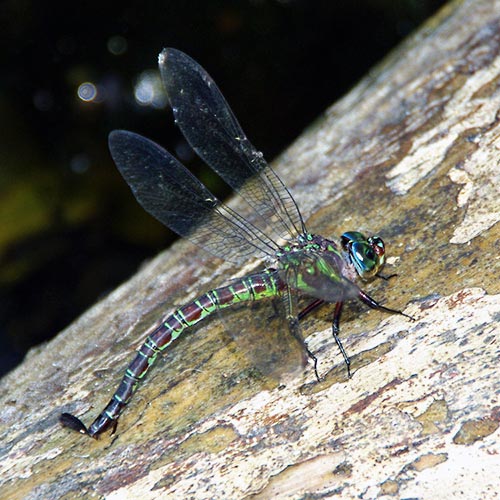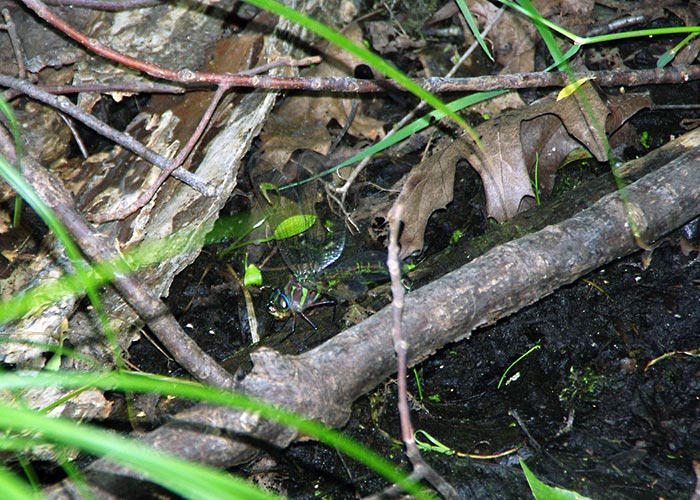Greetings, BugFans,
Recently, the BugLady was visiting her favorite ephemeral pond (which is a mere shadow of its former self these days). She heard buzzing/rustling in the vegetation and saw a very large dragonfly emerging above the grass tops and then ducking back down onto the mud. It also visited the edge of a fallen log, where against all odds (her bad luck photographing darners is legend), the BugLady got a few pictures of it. It turned out to be an aptly-named Swamp Darner.
Swamp Darner
Who is this dragonfly, and what was she doing there, blessing the final days of the ephemeral pond? Eipaeschna heros is her scientific name, and she is in a class by herself—the only member of her genus—in the family Aeshnidae, in the order Odonata. At 3 ½” long, she is the largest dragonfly that occurs in Wisconsin, larger even than the Common Green Darner, and one of the largest in the U.S.
She’s an impressive insect—large, broad-headed, her brown/maroon abdomen ringed with thin, green lines. Males and females look alike.
She was new for the Riveredge Nature Center dragonfly list but she was not new for Ozaukee County’s list. She might have been, were it not for the sharp eyes of State dragonfly expert, BugFan Bill, who recognized a picture of an Aeshnid naiad in an early BOTW episode as an SD naiad (hey—when you’re good, you’re good!).
Sluggish, plant-filled waters in shaded woodlands are home to the SD (also called the Hero Darner). It’s not tied to the water, feeding far and wide, low and high, daytime and dusk. If a flight of nuptial ants fills the sky (an increasingly rare sight, of late) SDs may form feeding swarms. SDs grab their prey out of the air, guided by those magnificent compound eyes, and they eat species of dragonflies smaller than themselves.
Males don’t patrol over water like other darners, but like other darners SDs perch vertically, flying up into the trees and hanging on twigs or bark. They’ve frequently been recorded flying into buildings; Eaton and Kaufman speculate, in Field Guide to Insects of North America, that the “deep shadows indoors suggest its usual shady forest haunts.” There was a tantalizing mention of a publication from 1903, The dragonflies (Odonata) of Tennessee, with a few records for Virginia and Alabama in which the author discussed “collecting larvae in Tennessee from ditches and marshes associated with chimney-building crayfish.” The Hine’s Emerald dragonfly, a Federally Endangered species, is also associated with crayfish.
She was ovipositing (laying eggs) at the edge of the shrinking ephemeral pond. SDs lay their eggs in damp and dry locations (but not in the water)—in the mud, in the trunks or soggy bark of standing and fallen trees, in stems, and at drying ponds. Her ovipositor (egg-laying apparatus) includes two pairs of blades that she uses to penetrate wood or plant stems. Some other Odonates lay their eggs out of water, too; their naiads may hatch and crawl to the nearest pond, or the eggs may aestivate until they are hydrated by rising water in spring.
Judging from the narratives of bloggers, SDs, with their 5 inch wingspans, grab the imagination. “This evening at dusk there was a steady migration of what appeared to be Swamp Darners heading due west…. I was able to catch and photograph one. The little bastard bit me with a surprisingly firm and painful pinch.” And “[It] swarms sometimes in open areas around swamps and slow water with numbers in the hundreds. These great looping flights can dazzle…. When flushed they sometimes fly directly at your forehead. Personally this makes me jump every time… In hand, this is a fabulous thing. Will make dragon chasers out of just about anyone.”
SDs range over eastern North America, more-or-less from Maine through Michigan to East Texas (with a jog into Kansas). They are one of approximately 15 species of dragonflies (out of about 400) that migrate, and they move down the Atlantic Coast in large numbers, sometimes as far as Mexico and the Bahamas. But they are very rare in Wisconsin; rare enough to be labeled a species of Special Concern here (Maine also lists them as a species of Special Concern).
Both the State and Federal governments have lists of Threatened and Endangered species—animals and plants that are legally designated and are protected by law. Many states also list Species of Special Concern, sort of a “let’s-keep-an-eye-on-these-guys” category. In Wisconsin, that list is developed by the Natural History Inventory, within the Bureau of Endangered Resources in the Wisconsin Department of Natural Resources. The SD is on the northwest edge of its range here; it has been recorded in only a few spots in Wisconsin, but its population is secure in the eastern part of the U.S.
Remember, the Dragonfly Woman needs your help documenting dragonfly swarms. If you see a swarm, large or small, feeding (static) or migrating, please fill out a report at: Report a Dragon Fly Swarm.
The BugLady

